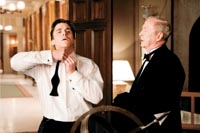Hitachi 42HDT52 42-inch Plasma HDTV Page 2
| The Short Form |
| $3,400 ($4,400 LIST) / 44.625 x 28.75 x 14.125 IN, 93 LBS WITH STAND / HITACHI.US/TV / 800-448-2244 |
| Plus |
| •Stunning design. •Sharp, detailed 1080i image. •Backlit thumbwheel remote. •Cool motorized swivel stand. |
| Minus |
•Relatively light blacks. •Some flicker in still images.  |
| Key Features |
| •1,024 x 1,024-pixel resolution •2 HDMI, 2 DTVLink (IEEE 1394), 2 component-video inputs •Digital cable-ready with CableCARD slot and TV Guide On Screen •2 customizable picture modes per input •Price $3,400 ($4,400 list) |
| Test Bench |
| The Hitachi 42HDT52 exhibited excellent grayscale characteristics on the test bench, with only mild variations before calibration in the Night/Standard setting and even better results afterward. It maintained a consistent level of black regardless of picture content. Multiburst resolution patterns revealed typical results for horizontal resolution, but flicker intruded on still vertical-resolution patterns from all sources - likely a result of ALiS (Alternate Lighting of Surfaces) technology and largely invisible in moving images. Color decoding underemphasized green significantly and red slightly for standard-def sources via component video, while high-def appeared more accurate, with only the green slightly undersaturated. Geometry and uniformity were excellent, as expected for a plasma, and no edge enhancement was visible with sharpness set to zero. |
The film is filled with dimly lit scenes, which I'll get to in a moment, but its brighter scenes really brought out the Hitachi's strengths. Bruce Wayne's training montage, which alternated between Henri Ducard (Liam Neeson) describing the tenets of Ninjitsu to Wayne (Christian Bale) and Ducard sparring with Batman on a frozen pond, served up a visual feast. The bluish-white ice floes looked natural and neutral instead of overly blue (as some TVs will make them), and fine details were visible everywhere, from the intricate carvings on Ducard's armored forearm to the woodgrain on the dojo floor.
When the scenes were darker, the Hitachi had a more difficult time. The black bars above and below the picture, and other black areas, appeared lighter than on many other plasmas I've seen. I also noticed a bit more video noise, which appeared in one instance as faintly discolored specks in the jacket worn by Jim Gordon (Gary Oldman) as he walks into his office, as well as in the surrounding doorframe and moldings. The noise became less noticeable if I reduced brightness, but as the best compromise I decided to stay at about 40% and live with a bit more noise to preserve shadow detail.
Despite the relatively light blacks, the Hitachi did a fine job rendering details in shadowy forms like the folds in Gordon's jacket as well as the stitches in Wayne's leather gloves and the subtly lit shapes of his fingers as he holds a stapler to Gordon's head. Also in the Hitachi's favor, I noticed only the slightest false contouring, which appears in many plasma TVs as visible bands of gradation between lighter and darker areas of the image. Instead, even the most difficult transitions between dark and darker appeared generally smooth and even.
Having had my fill of dark, I moved on to something brighter in high-def. HDNet's presentation of a NASCAR race in 1080i provided an excellent, er, vehicle to show off the Hitachi's sharp HD image. The thin girders in a distant grandstand were clearly discernible, and the picture appeared so crisp that it became glaringly obvious when the camera dropped even slightly out of focus.
This sharpness with 1080i sources is one of the Hitachi's major strengths, one it likely owes to its exceptional vertical resolution. Hitachi uses a technology it calls ALiS (Alternate Lighting of Surfaces) to achieve a native resolution of 1,024 x 1,024 pixels. This is significantly higher on the vertical axis than most high-definition 42-inch plasmas, which have 1,024 x 768 pixels. And, indeed, the image seemed sharper with 1080i sources than other 42-inch panels I've tested.
On the other hand, I also noticed somewhat more instability in paused or still-photo images than I usually see on a typical plasma TV. When I used my DVR controls to pause the race, for example, I saw the tiniest flicker throughout the image, mostly noticeable along horizontal edges of objects. None of this was visible when I restarted the program, however, and it wasn't an issue in normal viewing.
BOTTOM LINEFew plasma TVs on the market can compete with the Hitachi 42HDT52 on looks when turned off, and although it falls short of some plasmas on dark scenes, its loaded feature set and sharp high-def picture help tip the scales in its favor. Yes, it does cost more than many similar-size models. But in a world of no-name knockoffs and cutthroat profit margins, this much class can't come cheap.
- Log in or register to post comments




















































